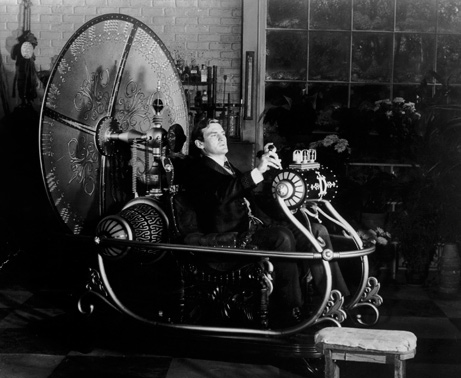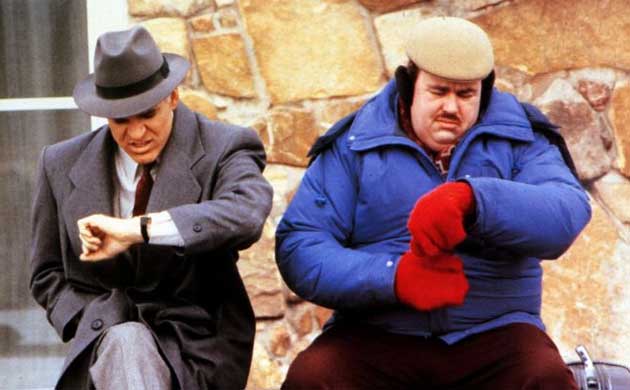The Clock.Time is like a bus. If you miss one another one will come. An almost transcendent 24 hour video of thousands of clips in syncronized time. We live in a world in which time is omnipresent. The tedium of its alleged linearity governing our lives, like well, clockwork. The entire financial system is based on time. We look at the time literally hundreds of times per day. it governs our lives; more pervasive than death and taxes which means more anxiety inducing. it is the greatest form of social control ever created. It is the narrative thrust in cinema and our daily lives. How can I tell that the past isn’t a fiction designed to account for the discrepancy between my immediate physical sensations and my state of mind? ~ Douglas Adams

image: http://homepage.mac.com/fahrenba/eport/standards.html Read More:http://everythingforever.com/einstein.htm---Einstein was followed in history by the colorful and brilliant Richard Feynman. Feynman developed the most effective and explanatory interpretation of quantum mechanics that had yet been developed, known today as Sum over Histories. Just as Einstein's own Relativity Theory led Einstein to reject time, Feynman’s Sum over Histories theory led him to describe time simply as a direction in space. Feynman’s theory states that the probability of an event is determined by summing together all the possible histories of that event. For example, for a particle moving from point A to B we imagine the particle traveling every possible path, curved paths, oscillating paths, squiggly paths, even backward in time and forward in time paths. Each path has an amplitude, and when summed the vast majority of all these amplitudes add up to zero, and all that remains is the comparably few histories that abide by the laws and forces of nature. Sum over histories indicates the direction of our ordinary clock time is simply a path in space which is more probable than the more exotic directions time might have taken otherwise.---
The idea of time snaking along, meandering, mosying, and takin’ its own sweet time is abhorrent to many since it implies a loss of control that the more exotic, -probably defined as non-white- conceptions of time invoked. Einstein himself rejected the separation we experience as the moment of now. He believed there was no division between past and future, instead a single existence, proposing instead a single existence that is relative and not absolute. That is, those who claim astral projection can claim several days of experience compressed into a period that others only perceive as several minutes. More practically, the closer to the speed of light, the slower time elapses, so theoretically timelessness exists.

Read More: http://thewere42.wordpress.com/2009/09/22/h-g-wells-9-predictions-that-have-and-havent-come-true/---The time machine was one of many future technologies that H.G. Wells popularized in his 20 novels and dozens of short stories. Although such a device isn’t one of Wells’s fancies that has since come to fruition, a time machine is within the realm of possibility, said Richard Muller, a physicist at the University of California, Berkeley. “There are many physicists who will tell you it is proven impossible, but that is not the case,” Muller said. “We just haven’t figured out how to do it.”---
Albert Einstein concluded in his later years that the past, present, and future all exist simultaneously. In 1952, in his book Relativity, in discussing Minkowski’s Space World interpretation of his theory of relativity, Einstein writes: Since there exists in this four dimensional structure [space-time] no longer any sections which represent “now” objectively, the concepts of happening and becoming are indeed not completely suspended, but yet complicated. It appears therefore more natural to think of physical reality as a four dimensional existence, instead of, as hitherto, the evolution of a three dimensional existence. Read More:http://everythingforever.com/einstein.htm
…In The Clock, Christian Marclay samples thousands of film excerpts indicating the passage of time. Spanning the range of timepieces, from clock towers to wristwatches and from buzzing alarm clocks to the occasional cuckoo, The Clock draws attention to time as a multifaceted protagonist of cinematic narrative. With virtuosic skill, the artist has excerpted each of these moments from their original contexts and edited them together to form a 24-hour montage, which unfolds in real time….

image: http://blog.habitual.com/2011/05/16/the-clock-debuts-at-lacma/desktop-the-clock/ Read More: http://www.huffingtonpost.com/edward-goldman/in-a-dark-room-intoxicated_b_873284.html---Every clip shows the hands of a clock moving forward yet another second or minute, and the astounding thing is that the onscreen time always corresponds with the actual time of your being in the museum, watching this very video. One wants to congratulate LACMA on its prescient purchase of this video in April for just under half a million dollars. I wouldn't be surprised if the Christian Marclay video, with the Golden Lion Award attached to it, soon commands a healthy price of a million bucks and major museums and billionaire collectors fight for the honor of owning it.--- Edward Goldman. Read More:
…While constructed from a dizzying variety of periods, contexts and film genres whose storylines seem to have shattered in a multitude of narrative shards, The Clock uncannily proceeds at a unified pace as if re-ordered by the latent narrative of time itself. Because it is synchronized with the local time of the exhibition space, the work conflates cinematic and actual time, revealing each passing minute as a repository of alternately suspenseful, tragic or romantic narrative possibilities. Read More:http://www.artdaily.org/index.asp?int_sec=2∫_new=48036
Consequently, but not surprisingly, the philosopher Walter Benjamin completed the circle. Benjamin’s messianic Marxism tried to conceive of an alternative concept of history and temporality. He termed this alternative time ÈNow-Time” which was a fulfilled or contracted time providing a model of messianic time as opposed to the repetitive, “homogenous and empty time” implied by vulgar-Marxist, historicist, or evolutionist historiography. It was a powerful critique of another “ism” which exposed it banality in practice. In doing so, Benjamin enlisted theology; more particularly, the Jewish and initial Christian motif of messianic time, to “blast open” the historical horizon of capitalist modernity. The reluctance of other Marxists to adopt this does tender render the purpose of the exercise mute; in other words to preserve it materiality and fight over the spoils. But, as benjamin said, how are we to conceive of this theological allusion from a materialist point of view? Hence, history is never completed or perfect but radically imperfect and open to its retroactive modification.
…’The Clock’ plays with how audiences experience narrative in cinema, examining the conventions and devices through which filmmakers create a persuasive illusion of duration. When watching a film, an audience is removed from normal time and swept up in a new register that corresponds to the narrative at hand. ‘The Clock’ transforms this condition of cinema: time, in this case, corresponds precisely to the actual time beyond the work. The audience will have the peculiar awareness of experiencing a fictional event, or countless events, at what appears to be the same time as when they watch it in the gallery . Read More:http://www.whitecube.com/exhibitions/cm/

Read More: http://blog.art21.org/2010/11/01/letter-from-london-the-time-of-your-life/---Marclay’s alignment of real and cinematic time in The Clock makes the work itself a kind of timepiece. You know how long you have until the gallery attendants kick you out (kindly). In that way, the work records the process of its being watched, and feeds back, if obliquely, to the phenomenological self-consciousness of minimalist sculpture – only here, you’re made aware of your existence in time rather
n space. You are here, watching a film, at this precise time. It’s a strange jolt.---
ADDENDUM:
Marclay’s marathon is a merciless object lesson in Henri Bergson’s distinction of real time and duration. In non-Marclay circumstances, there is an acute difference between time as experienced by moviegoers and time as depicted (compressed, manipulated) by moviemakers. Narrative and mood and investment in the fate of characters and the desire to stay with the stars you love keep you in a place and state where time stands still. Or rather, to avoid clichés as one ought when philosophizing, where time has its own logic – reel time, let’s call it. In Marclay, you lose the actual narratives from which his wrested clips are bleeding chunks. Although unexpected delights of surrogate narrative do offer themselves in fractional compensation, the conceptual purpose of challenging unexamined expectations of time seems the primary purpose of Marclay’s project.
Adopting Bergson, the great if forbidding philosopher of cinema Gilles Deleuze drew a distinction between two temporal conceptions of movement in time, what he calls privileged instants and any-instants-whatever. The bizarre thing in Marclay is that the epitome of the latter, arbitrary but relentless markers of time, become exemplars of the former, moments of poise, drama, accent and focus. The Clock is a minute-by-minute speedball of enervating expectation. Read More:http://artcritical.com/2011/02/05/christian-marclay/
—————————————————
“The original task of a genuine revolution […] is never merely to ‘change the world’, but also – and above all – to ‘change time’. Modern political thought has concentrated its attention on history, and has not elaborated a corresponding concept of time. Even historical materialism has until now neglected to elaborate a concept of time that compares with its concept of history.”( Giorgio Agamben ) Read More:http://anthropologicalmaterialism.hypotheses.org/844
—————————————————-
While Benjamin’s Jetztzeit introduces a redemptive short-circuit between certain moments of the past (e.g. failed or unfulfilled revolutions) and the now of political acting irreducible to “homogeneous and empty time” of official historiography, the ‘perverse’ Jetztzeit of capital cannot escape its measurement by abstract time. Rather, the capitalist “now-time” always demands an endless repetition of its retroactive measurement – even though a final measurement is endlessly postponed. Against this form of spurious infinity, Benjamin insisted on a messianic cessation of all events breaking off this inner temporal dynamic of capital-time. Read More:http://anthropologicalmaterialism.hypotheses.org/844






 COMMENTS
COMMENTS